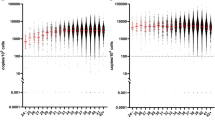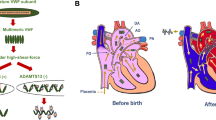Abstract
To determine predictive factors for neonatal thrombocytopenia in deliveries with immune thrombocytopenia (ITP), we conducted a retrospective study at a tertiary hospital between 1997 and 2013. During this period, 30 women with ITP delivered 44 children. Neonatal thrombocytopenia (<100 × 109/L) at birth was observed in seven neonates; four of these cases were severe (<50 × 109/L). No cases were complicated by intracranial hemorrhage, and there was no neonatal mortality. Platelet counts at birth of neonates born to mothers, who had first been diagnosed with ITP during pregnancy were significantly higher than those born to mothers diagnosed with ITP before pregnancy. There were significant correlations between neonatal platelet counts in the first and second siblings at birth (P = 0.015) and at nadir (P = 0.035). Platelet counts of neonates born vaginally were significantly more likely to decline after birth than those delivered by cesarean section (13/16 vs. 10/23, P = 0.024). In conclusion, diagnosis of ITP before pregnancy was significantly associated with neonatal thrombocytopenia, and the platelet count of an older sibling is a strong predictor for that of the next baby. The delivery mode may be an indicator of the timing of platelet count nadir after birth.


Similar content being viewed by others
Abbreviations
- CBC:
-
Complete blood count
- emCS:
-
Emergency cesarean section
- ITP:
-
Immune thrombocytopenia
- IVIG:
-
Intravenous immunoglobulin
- mPSL:
-
Methylprednisolone
- plCS:
-
Planned cesarean section
- PSL:
-
Prednisolone
References
Gill KK, Kelton JG. Management of idiopathic thrombocytopenic purpura in pregnancy. Semin Hematol. 2000;37:275–89.
Cines DB, Blanchette VS. Immune thrombocytopenic purpura. N Engl J Med. 2002;346:995–1008.
Van der Lugt NM, van Kampen A, Walther FJ, Brand A, Lopriore E. Outcome and management in neonatal thrombocytopenia due to maternal idiopathic thrombocytopenic purpura. Vox Sang. 2013;105:236–43.
Webert KE, Mittal R, Sigouin C, Heddle NM, Kelton JG. A retrospective 11-year analysis of obstetric patients with idiopathic thrombocytopenic purpura. Blood. 2003;102:4306–11.
Veneri D, Franchini M, Raffaelli R, Musola M, Memmo A, Franchi M, et al. Idiopathic thrombocytopenic purpura in pregnancy: Analysis of 43 consecutive cases followed at a single Italian institution. Ann Hematol. 2006;85:552–4.
Neunert C, Lim W, Crowther M, Cohen A, Solberg L Jr, Crowther MA, American Society of Hematology. The American Society of Hematology 2011 evidence-based practice guideline for immune thrombocytopenia. Blood. 2011;117:4190–207.
Koyama S, Tomimatsu T, Kanagawa T, Kumasawa K, Tsutsui T, Kimura T. Reliable predictors of neonatal immune thrombocytopenia in pregnant women with idiopathic thrombocytopenic purpura. Am J Hematol. 2012;87:15–21.
Iwata A, Matsubara K, Hirata T. Repetitive combined therapy of high-dose immunoglobulins and steroids for a neonate with severe passive autoimmune thrombocytopenia. J Jpn Soc Perinat Neonatal Med. 2005;41:85–8 (in Japanese with English abstract).
Christiaens GC, Nieuwenhuis HK, Bussel JB. Comparison of platelet counts in first and second newborns of mothers with immune thrombocytopenic purpura. Obstet Gynecol. 1997;90:546–52.
Roberts I, Stanworth S, Murray NA. Thrombocytopenia in the neonate. Blood Rev. 2008;22:173–86.
Ajzenberg N, Dreyfus M, Kaplan C, Yvart J, Weill B, Tchernia G. Pregnancy-associated thrombocytopenia revisited: assessment and follow-up of 50 cases. Blood. 1998;92:4573–80.
Samuels P, Bussel JB, Braitman LE, Tomaski A, Druzin ML, Mennuti MT, et al. Estimation of the risk of thrombocytopenia in the offspring of pregnant women with presumed immune thrombocytopenic purpura. N Engl J Med. 1990;323:229–35.
Payne SD, Resnik R, Moore TR, Hedriana HL, Kelly TF. Maternal characteristics and risk of severe neonatal thrombocytopenia and intracranial hemorrhage in pregnancies complicated by autoimmune thrombocytopenia. Am J Obstet Gynecol. 1997;177:149–55.
Kelton JG. Idiopathic thrombocytopenic purpura complicating pregnancy. Blood Rev. 2002;16:43–6.
Gernsheimer T, James AH, Stasi R. How I treat thrombocytopenia in pregnancy. Blood. 2013;121:38–47.
Fujimura K, Harada Y, Fujimoto T, Kuramoto A, Ikeda Y, Akatsuka J, et al. Nationwide study of idiopathic thrombocytopenic purpura in pregnant women and the clinical influence on neonates. Int J Hematol. 2002;75:426–33.
Sharon R, Tatarsky I. Low fetal morbidity in pregnancy associated with acute and chronic idiopathic thrombocytopenic purpura. Am J Hematol. 1994;46:87–90.
Fujita A, Sakai R, Matsuura S, Yamamoto W, Ohshima R, Kuwabara H, et al. A retrospective analysis of obstetric patients with idiopathic thrombocytopenic purpura: a single center study. Int J Hematol. 2010;92:463–7.
Kunishima S, Kashiwagi H, Otsu M, Takayama N, Eto K, Onodera M, et al. Heterozygous ITGA2B R995 W mutation inducing constitutive activation of the αIIbβ3 receptor affects proplatelet formation and causes congenital macrothrombocytopenia. Blood. 2011;117:5479–84.
British Committee for Standards in Haematology General Haematology Task Force. Guidelines for the investigation and management of idiopathic thrombocytopenic purpura in adults, children and in pregnancy. Br J Haematol. 2003;120:574–96.
Provan D, Stasi R, Newland AC, Blanchette VS, Bolton-Maggs P, Bussel JB, et al. International consensus report on the investigation and management of primary immune thrombocytopenia. Blood. 2010;115:168–86.
Acknowledgment
This work was supported by a research grant from the Japanese Ministry of Health, Labour and Welfare.
Conflict of interest
The authors declare that they have no conflict of interest.
Author information
Authors and Affiliations
Corresponding author
About this article
Cite this article
Kawaguchi, K., Matsubara, K., Takafuta, T. et al. Factors predictive of neonatal thrombocytopenia in pregnant women with immune thrombocytopenia. Int J Hematol 99, 570–576 (2014). https://doi.org/10.1007/s12185-014-1562-6
Received:
Revised:
Accepted:
Published:
Issue Date:
DOI: https://doi.org/10.1007/s12185-014-1562-6




